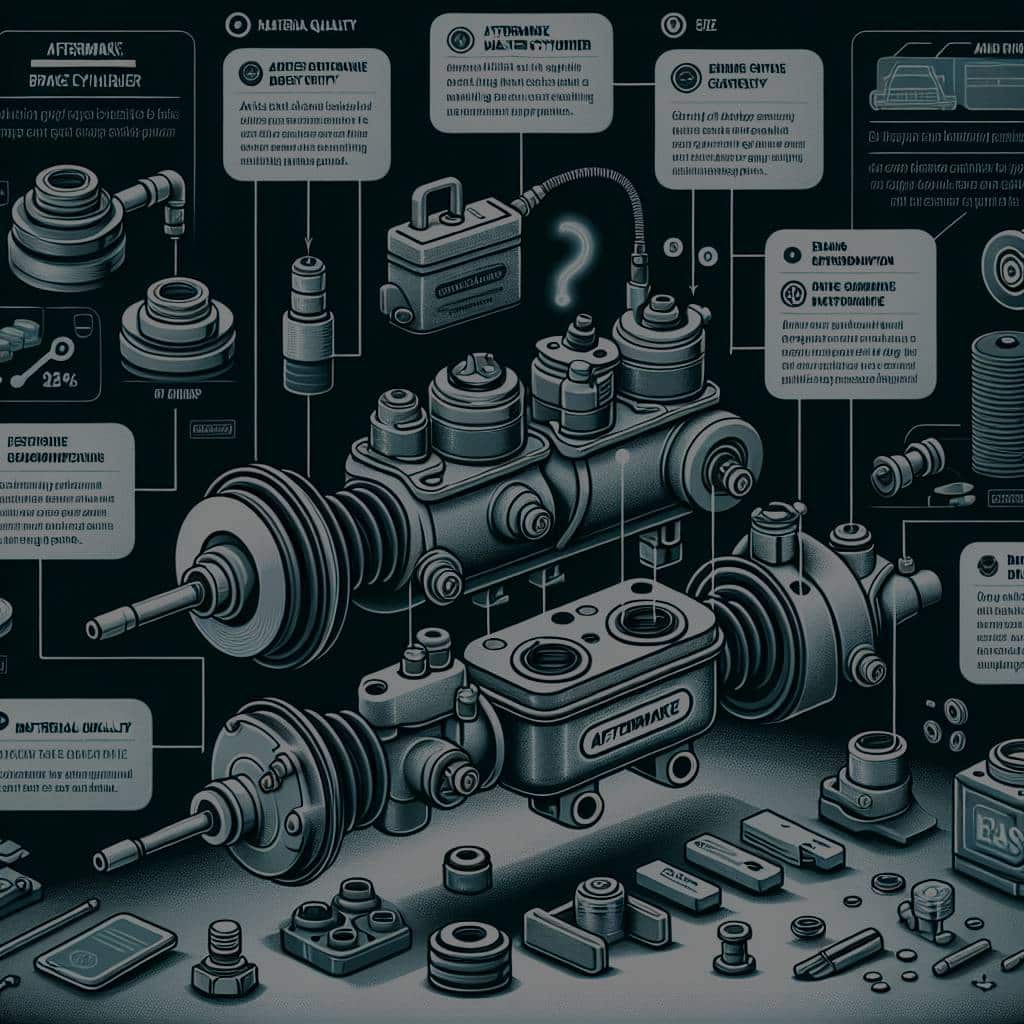The brake master cylinder is one of the most crucial components of your vehicle’s braking system. It plays a pivotal role in ensuring the safety and efficiency of your ride. When you press down on the brake pedal, the master cylinder converts that mechanical force into hydraulic pressure. This pressure travels through the brake lines to your vehicle’s brake calipers and shoes, causing your vehicle to slow down or stop.
However, like every other part of your vehicle, the brake master cylinder can wear out over time, leading to decreased performance and potential safety risks. In such cases, turning to aftermarket options can be a wise decision. The aftermarket brake master cylinders often offer superior performance and durability compared to original equipment manufacturer (OEM) parts. But how do you choose the right one for your vehicle? Well, that’s what we’re here to help you with.
In the same genre : How to Choose the Best Air Compressor for Mobile Tire Inflation for Road Trips?
Understanding the Purpose of the Brake Master Cylinder
Before we delve into how to choose an aftermarket brake master cylinder, it’s important to understand its function in the braking system. The brake master cylinder serves two primary purposes. The first is to create hydraulic pressure in the brake lines. The second is to divide this pressure evenly among all the wheels.
When the brake master cylinder becomes faulty, it can lead to several complications. The brake pedal may feel spongy or sink to the floor. The brakes themselves may start to drag or fail completely. In the worst-case scenario, a defective master cylinder can result in total brake failure, posing a severe safety risk. Therefore, it’s crucial to replace a faulty master cylinder promptly with a quality aftermarket part.
Also read : Wedding planning in France: the advantages of hiring a wedding planner
What to Look for in an Aftermarket Brake Master Cylinder
While choosing an aftermarket brake master cylinder, you must consider several factors to ensure you’re getting a product that meets, if not surpasses, the performance and safety standards of the OEM part.
Firstly, consider the brand reputation. Well-known brands usually guarantee better quality and reliability. They are often backed by warranties and customer reviews, providing you with peace of mind.
Secondly, the brake master cylinder you choose should ideally be a direct fit for your vehicle’s make and model. This ensures easy installation and compatibility with your vehicle’s other components.
The material used in the construction of the cylinder is another key consideration. It should be resistant to corrosion, wear, and heat.
Lastly, consider whether the aftermarket brake master cylinder comes with a reservoir. Having a reservoir included saves you time and hassle during installation.
Differences Between OEM and Aftermarket Brake Master Cylinders
It’s vital to understand the differences between OEM and aftermarket brake master cylinders to make an informed choice. OEM brake master cylinders are made by the vehicle’s manufacturer. They are designed to provide the exact fit and function as the original part. However, they can be pricier and may not offer the same level of performance and longevity as aftermarket options.
On the other hand, aftermarket brake master cylinders are made by independent companies. They are often designed to improve upon the original design, offering superior performance and durability. They are typically more affordable and easier to find than OEM parts. However, quality can vary between different brands and products, so it’s crucial to do your research and choose carefully.
Knowing When to Replace the Brake Master Cylinder
Knowing when to replace your brake master cylinder is just as important as knowing how to choose a replacement. There are several tell-tale signs that your brake master cylinder needs replacing.
If you notice a decrease in braking power, or if the brake pedal feels spongy or sinks to the floor, it may be due to a faulty brake master cylinder. Other symptoms can include abnormal brake pedal behavior, contaminated brake fluid, or illuminated warning lights on your dashboard.
It’s crucial to respond promptly to these warning signs. Ignoring them can lead to total brake failure, which can be dangerous. Regular inspections and maintenance of your vehicle’s braking system can help you identify these issues early and take appropriate action.
Importance of Professional Installation
While some car enthusiasts might be tempted to install the new brake master cylinder themselves, professional installation is highly recommended. The brake master cylinder is a complex and critical component of your vehicle’s braking system – a system that your safety relies on.
A professional mechanic has the proper tools, skills, and experience to install the brake master cylinder correctly. They can also bleed the brake system, which is crucial to remove any air that might have entered the system during installation.
Remember, a well-functioning brake system is not just about having high-quality components – it’s also about ensuring these components are installed and maintained correctly.
Choosing the right aftermarket brake master cylinder for your vehicle is not merely about improving stopping power or enhancing performance. It’s about ensuring your safety and the safety of others on the road. By understanding the role of the brake master cylinder, knowing what to look for in a replacement, recognizing the signs of a failing master cylinder, and emphasizing professional installation, you can make a knowledgeable decision and invest in the right product.
Difference in Brake Master Cylinder Designs
Diving deeper into the selection process, understanding the difference in brake master cylinder designs can be quite handy. Primarily, there are two types of brake master cylinders – single and dual. Each of these designs has its own set of advantages and specific uses.
A single master cylinder has only one piston that controls all four brakes. This design was common in older vehicles but is rarely used in modern cars due to safety concerns. If the single line fails, it can lead to a total loss of brakes.
Modern vehicles, on the other hand, use a dual master cylinder. This design has two separate hydraulic circuits. Each circuit controls two brakes – one for the front brakes and one for the rear. This design enhances safety because even if one circuit fails, the other will still function, thereby providing some braking power.
When choosing an aftermarket brake master cylinder, it’s best to go with a dual design. It offers better performance and safety. However, remember that it must be compatible with your vehicle’s braking system.
Performance and Pricing of Aftermarket Brake Master Cylinders
The performance and pricing of aftermarket brake master cylinders can vary significantly. It’s crucial to strike a balance between cost and quality. Don’t fall into the trap of choosing the cheapest option available. While it might save you money in the short term, it might not deliver the desired performance or durability.
When it comes to performance, aftermarket brake master cylinders are often designed to provide enhanced stopping power. They are built to withstand extreme conditions and high pressure. Therefore, they can offer more effective and reliable braking.
On the pricing front, aftermarket options tend to be more affordable than OEM parts. However, this doesn’t mean that all aftermarket parts are cheap. High-quality aftermarket brake master cylinders, particularly those from reputable brands, can be quite pricey. But they often offer excellent value for money due to their superior performance and durability.
Conclusion
Selecting the right aftermarket brake master cylinder is a crucial task that requires a deep understanding of your vehicle and its braking system. The role of the brake master cylinder is critical in ensuring efficient braking, and therefore, replacing a malfunctioning one with a high-quality aftermarket product is highly important.
Remember that it’s not just about choosing a product that offers enhanced stopping power. It’s also about considering factors like the brand reputation, the compatibility with your vehicle, the design, the material used, and the presence of a reservoir. Be aware of the differences between OEM and aftermarket brake master cylinders, and balance cost and quality when making your selection.
Lastly, even the best brake master cylinder won’t perform optimally if not installed correctly. Hence, professional installation and regular maintenance of your vehicle’s braking system are highly recommended. After all, investing in the right aftermarket brake master cylinder is about ensuring your safety and that of others on the road.











